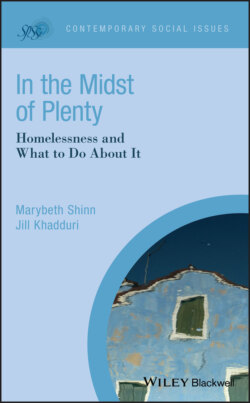Читать книгу In the Midst of Plenty - Marybeth Shinn - Страница 20
Age, Race, and Gender
ОглавлениеWhen asked to imagine a homeless person, most people think of an ill‐kempt middle‐aged man. It is true that there are more adults than children who are homeless, but the age at which a person in the United States is most likely to spend a night in shelter is infancy. Figure 1.1 shows the percentage of people of different ages who experience sheltered homelessness, calculated by dividing the number of people HUD reports as experiencing sheltered homelessness over the course of the year by the numbers in the same age groups in the total U.S. population.
As the figure shows, infants under the age of one are at higher risk of homelessness than any other age group. Risk remains high during the preschool years and then drops when children enter school and childcare costs go down. Risk continues to fall in adolescence and rises again in early adulthood (the period through age 24 that is included in youth homelessness) and especially the late 20s, when some young people are the parents of those young children. Risk remains nearly as high in middle adulthood and then falls off sharply among older adults. One's picture of a “typical homeless person” may need to be broadened.
Among adults (including youth over 18), more men than women experience homelessness over the course of a year, 62% vs. 38% (Henry, Mahathey, et al., 2018). The numbers are still more uneven among those who do not have children with them, 71% men vs. 29% women among those using a shelter at some time during a year. Even in families, over a fifth (22%) of adults are men, and data from the Family Options experiment suggest this number would be still higher—perhaps 27%—if family shelters did not exclude them.
Figure 1.1 Percentage of U.S. Population Using Shelter Over the Course of a Year (2016–2017) by Age Group. Numbers of people experiencing homelessness from Supporting Resources for the 2017 Annual Homeless Assessment Report to Congress Part 2 (Henry, Bishop, et al., 2018). Numbers of people in the U.S. population for 2017 from annual estimates of the resident population by single year of age and sex for the United States, States, and Puerto Rico Commonwealth: April 1, 2010 to July 1, 2017 (U.S. Census Bureau, 2018).
HUD does not include people, overwhelmingly women, who use domestic violence shelters, in these estimates, but the number of beds in domestic violence shelters is not large, so this does not account for the difference (Henry, Bishop, et al., 2018). Women, especially women with children, may be more able than men to persuade kin or non‐kin to take them in to doubled‐up households,13 and they have access to some additional safety‐net resources. Unaccompanied young people (children and youth under the age of 25) are somewhat more likely to be male, especially if they are on the street, but unaccompanied youth include more women and girls when compared with all adults who are homeless on their own (Henry, Mahathey, et al., 2018; Toro, Dworsky, et al., 2007).
African Americans and Native Americans are especially likely to become homeless (Burt et al., 1999; Hopper & Milburn, 1996). African Americans are particularly heavily represented among families who use shelters, with 52% of that population identifying as black or African American in 2017. By comparison, the African American share of the family population with incomes below the federal poverty level was 23% in the same year. Both shares have dropped somewhat in recent years (Henry, Bishop, et al., 2018).
Homelessness is largely an urban phenomenon. People who experience homelessness over the course of a year are more likely to be in principal cities14 (72.5%) than either the entire U.S. population (32.5%) or people living in poverty (39.6%), although the number in suburban and rural locations has increased from 23.1 to 27.5% since 2007 (Henry, Bishop, et al., 2018). Here again, homeless services may shape or distort our understanding of people who experience homelessness. Most services are located in cities, so people who become homeless in nearby areas without shelters may migrate there. A study that used HMIS data to look at migration patterns in two states where that was possible, Iowa and Michigan, documented some migration from suburban areas into cities, based on the zip code of the last permanent address before the person entered a shelter. The study found essentially no migration out of rural areas (Leopold, Culhane, & Khadduri, 2017).
Youth who become homeless may or may not differ from the general population in their locale with respect to race or ethnicity (Toro, Dworsky, et al., 2007), but they are disproportionately sexual minorities. Estimates of the proportion of lesbian, gay, bisexual, and transgender (LGBT) youth range from 6 to 40% (Durso & Gates, 2012; Toro, Dworsky, et al., 2007). The 40% estimate comes from a national survey of 354 organizations serving homeless youth (primarily 18 and older) that made special efforts to include agencies serving LGBT youth (Durso & Gates, 2012); the midpoint of earlier estimates is closer to 20% (Toro, Dworsky, et al., 2007). The recent Voices of Youth Count Survey conducted in 2016 and 2017 found no significant difference between urban and rural areas in the prevalence of homelessness for young adults 18–25 (Morton et al., 2018), but that survey also was relatively small and included couch surfing as well as literal homelessness.
